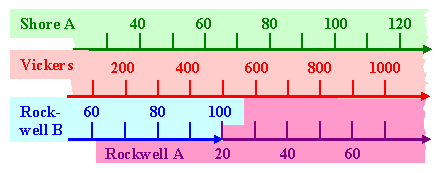 |
All people, without exception, have a pretty good idea of what "hardness" means in
the context of materials properties. Extremely few people, however, have a decent notion of what the terms "yield stress"
or "maximum elongation" tells us about materials properties. |
|
 |
Ironically, while the two latter properties are well-defined, hardness is not! |
|
 |
Yield stress, as we
know, can be measured in precisely defined ways, and can be expressed in terms of basic material properties. |
|
 |
Hardness is different. It is not uniquely defined, and that means there is no unambitious
way of measuring it. There are only some recipes
- that's why we have several hardness scales in parallel. |
 |
Essentially, there are two types of basic hardness measurement set-ups (plus some more unusual
principles). |
|
 |
1. Measure the size of an indentation made by some indenter
under a known load. The following hardness tests use this principle: |
|
 |
2. Measure the depth to which an indenter penetrates under specified
conditions. The following hardness tests use this principle: |
|
 |
More unusual or outdated are
- Mohs hardness scale (the first one), defined via "what scratches what".
- Shore scleroscope principle: measure the rebound of a ball or hammer.
|
 |
In the "Materials in Action"
series, "Structural Materials", page 100, the scales are compared (which is not easy). |
|
 |
Here we usually use the Vickers
scale. It runs from 0 to about 3000; the unit is essentially that of
stress (Pa); but the numbers are given in outdated units: |
|
 |
In the "Materials in Action" series you will find an unusual unit: "kgf", which
is kilogram-force, which is something different from a "kg", because
that was and is a mass. Nevertheless, the unit for the hardness is kg/mm2; what is meant is the force
that a mass of one kg experiences in the gravitational field of the earth. In German the unit "kilopond"
(kp) was used; it's the same thing. Of course we have
1kg/mm2
» 10N/10–6 m2 = 10–5 Pa |
 |
Here is a table with some Vickers hardness data: |
| |
| Material | Vickers hardness |
| Material |
Vickers hardness | |
Material | Vickers hardness | | Sn |
5 | Limestone | 250 |
Polypropylene | 7 | | Al |
25 | MgO | 500 |
Polycarbonate | 14 | | Au |
35 | Window glas | 550 | PVC |
16 | | Cu | 40 |
granite | 850 | Epoxy | 45 |
| Fe | 80 | quartz |
1200 |
| |
| Mild steel | 140 |
Al2O3 | 2500 | |
| | Hardened steel | 900 |
WC | 2500 | | |
|
 |
Hardness measures in some lumped way a combination of elastic, plastic, and fracture properties,
i.e. it combines somehow Yield stress, Youngs modulus and fracture parameters. |
|
 |
There is, however, no unique formula giving the hardness number as a function of the primary parameters. |
 |
The best one can do is to provide some approximate relations for certain classes of materials. |
|
 |
For relatively soft metals and for steel, respectively, there is a very simple relation between the Vickers
Hardness HV
and the yield stress RP or the tensile strength RM |
| |
| HV |
» |
3 RP | "soft" metals |
| 3.2 RM | steel |
|
|
|
 |
Of course, you have to express the strength parameters in kg/mm2, too |
 |
This makes life easier and explains why we have not much dealt with hardness here: For our
materials of interest, it is essentially the same as the much better defined parameters governing plastic deformation. |
|
 |
Life would be even more easier, if most scientists would use the same hardness scale. Of course, they don't,
so here is an approximate conversion, adopted form the "Materials in Action " Series already
mentioned. |
| |
|
© H. Föll (MaWi 1 Skript)
